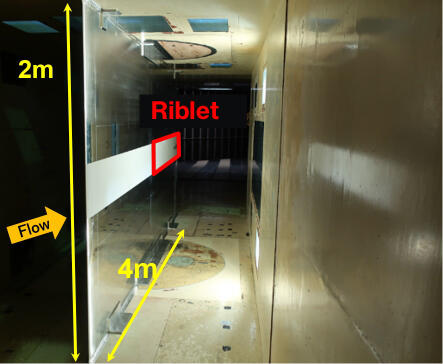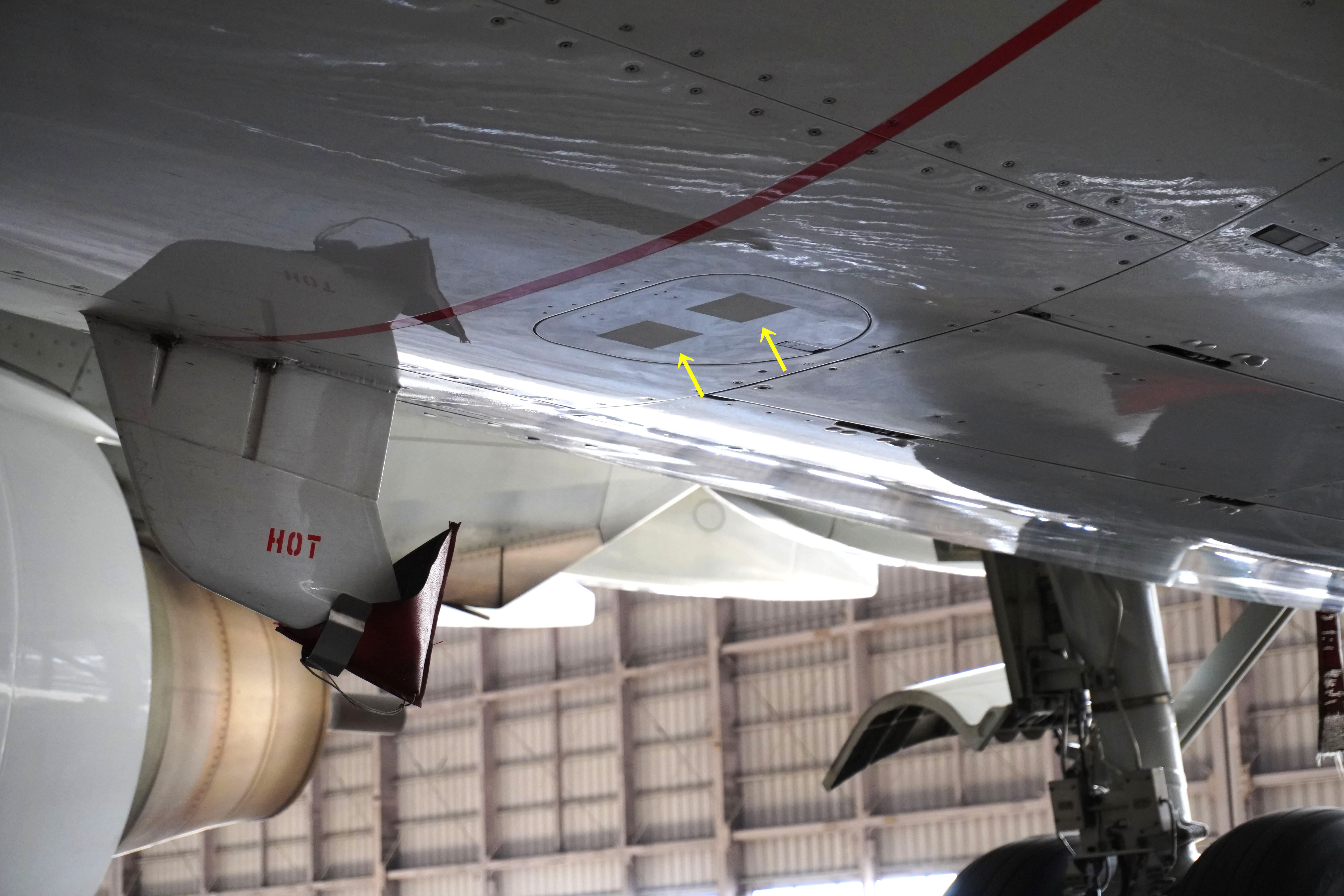
Aviation Technology Directorate

Riblets applied to aircraft (areas marked by yellow arrows)
Fine Sharkskin-like Vertical Grooves (Riblets) Solve Problems
for the
Aviation Industry
JAXA's Unique Riblets Aim to
Create Eco-friendly Aircraft
"How can we make aircraft fly more fuel-efficiently?"
This is a universal challenge for the aviation industry.
One solution to this problem is "riblets," which control airflow by means of fine
longitudinal grooves that resemble sharkskin. We spoke with KURITA Mitsuru of the Aviation
Environmental Sustainability Innovation Hub about the "JAXA riblet technology," an outcome
of research and development by JAXA.
JAXA's technology responds to a long-standing challenge of making aircraft more fuel efficient
Riblet technology is an aerodynamic technology inspired by sharkskin.
To improve the fuel efficiency of an aircraft, it is important to reduce aerodynamic drag acting on the surface of aircraft. The most efficient way of achieving this is to reduce the skin-friction drag of the airframe surface, which accounts for the greater part of an aircraft's drag. One technology capable of achieving this is the riblet.
JAXA is currently conducting performance tests to put riblets to practical use, and Kurita, who has been involved in riblet R&D, explained JAXA's riblet technology in the following manner:


Diagram of the riblet effect
"Riblets are an aerodynamic technology used to reduce skin friction drag by creating fine longitudinal grooves (the grooves are about 0.1 mm apart for passenger planes) on the surface of the airframe. We normally tend to think that a smooth airframe surface is more effective in reducing air drag, but creating fine longitudinal grooves actually reduces the surface area where fast-flowing air hits. This is the principle by which riblets reduce skin friction drag. JAXA is also researching riblet shapes that produce the best aerodynamic performance (the ability to control the various effects of airflow)."
Improving aerodynamic performance, workability, and durability is the key to practical application
With regard to improving aerodynamic performance, Kurita noted, "We are amassing technologies with the cooperation of many people."

Evaluating riblets' aerodynamic performance in JAXA wind tunnel tests simulating flight conditions
"We holed ourselves up in the wind tunnel test facility and carried out a series of tests to verify the performance of the riblets in reducing skin friction drag. There were times when I wondered if we would ever be able to create a truly effective riblet, but I persevered alongside my colleagues and the construction companies and, through repeated fine-tuning and experimentation, we were able to create a riblet that exhibited remarkable aerodynamic performance."
Even after successfully designing a riblet with good performance, however, there were still issues that needed to be resolved before the riblet could be applied to actual aircraft, requiring further improvements in workability and durability.
JAXA has been working with airlines and construction companies to research two different processing methods: transfer sheet molding (Paint-to-paint method) using existing aircraft paint, and laser processing. The key to putting these methods to practical use is how quickly they can be applied to create riblets over the entire aircraft surface.

For example, the passenger aircraft currently used by airlines have very high operating rates, making it impractical to halt flight operations to set aside time for applying riblets. A high level of workmanship is therefore required so that the riblets can be applied to aircraft fuselages during normal maintenance times.
Flight tests to assess durability have been conducted since July 2022 on aircraft operated by Japan Airlines Co., Ltd. (JAL), and a media briefing on the test results was held in a JAL hangar at Haneda Airport in February 2023.

"Durability tests using JAL aircraft were conducted by applying JAXA riblets to aircraft actually in operation (applied in small areas of about 7.5 x 7.5 cm). We evaluated whether the aerodynamic performance of the riblets was maintained after 1,500 flying hours for both construction methods (transfer sheet molding (Paint-to-paint method) and laser processing) by performing about six flight cycles per day along with regular airframe cleaning, maintenance, and inspection in actual operational environments."
Going forward, JAXA intends to establish practical application techniques for its riblet by developing a quick application method and a more effective shape.
Improving the international competitiveness of Japanese aircraft and expanding riblet use to other fields
"If JAXA's riblet can be put to practical use by improving its aerodynamic performance, workability, and durability, the day may come when this riblet can be applied to every aircraft that takes to the skies. This would reduce CO2 emissions from aircraft, meaning that our technology could be used to help prevent global warming. We would like to convert as many aircraft as possible into eco-friendly aircraft. Given the significance of this research and development for realizing a sustainable future, we are determined to set a firm course toward commercial use."
Collaboration by JAXA with the various companies that have been involved in R&D thus far and with end users such as airlines and construction companies will be essential for putting this technology to practical use.
"JAXA's riblet technology has come this close to practical application thanks to the cooperation of many companies, universities, and colleagues who have worked with us on research and development up to this point. I would like to bring all of our efforts together to spread the word about JAXA's riblet technology."

The name "Refresh" is an abbreviation of "RiblEt Flight RESearcH for carbon neutrality"
Profile

|
|
|---|
All the images are copyrighted ©JAXA unless otherwise noticed.
- Home>
- Global Activity>
- Public Relations>
- JAXA’s>
- JAXA's No.91>
- Aviation Technology Directorate